MUSEUM DU LOUVRE


The title of most visited museum in the world is no accident. With over 60,000 m2, the Louvre has a magnificent collection selected from the Middle Ages to the mid-19th century, divided into:
three wings:
- Richelieu,
- Denon
- and Sully,
and eight departments:
- Egyptian antiquities,
- antiquities from the east,
- Greek, Roman and
etruscan,
- islamic art,
- decorative arts,
- paintings,
- engravings and drawings,
- and sculptures.




World-renowned works such as the Mona Lisa, the Venus de Milo, the Victory of Samothrace, the Lacemaker by Vermeer, the Slaves by Michelangelo, and thousands of others, fascinate millions of tourists year after year.


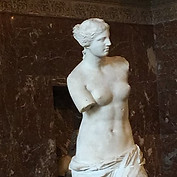


Essential tips for visiting the Louvre:
The best option is to buy your online entry.
The purchase can be made on the museum's official website ( www.ticketlouvre.fr/louvre/b2c/index.cfm/home ), Choose a set date and time for your tour. You make the purchase and then print your ticket - print@home option. With the ticket in hand, we indicate the entrance through the Richelieu Passage, emptier than the others: you enter through a corridor that goes from Rue de Rivoli to the pyramid. On this route you will see the entrance for groups with guides and for those who possess tickets purchased on the museum's website, over the internet. But don't be late because the tolerance is 30 minutes.
The museum has four entrances. Most people know only the main one, which is the pyramid. Because of this, it is almost always crowded and there is a huge queue to buy tickets at the counters.

Another entrance, also very popular, is through the Carrousel du Louvre, a gallery with many interesting shops, restaurants and the famous inverted pyramid (remember the Dan Brown movie, The Da Vinci Code? That's right).
There is also the Port des Lions entrance, but it is always doubtful because it is sometimes closed. I wouldn't risk...


Ticket purchase terminals
But, if you haven't planned ahead, a good tip is that there are terminals to buy tickets right there (credit card), in the lobby where the service desks are, next to the ascent to the wings.


Entrance is valid for the entire day. That means you can leave and come back, but keep your ticket well...
Also it must be shown at the entrance of each ward: Denon, Richelieu or Sully.
Access to one of the 3 wings - Mandatory to present the ticket for admission
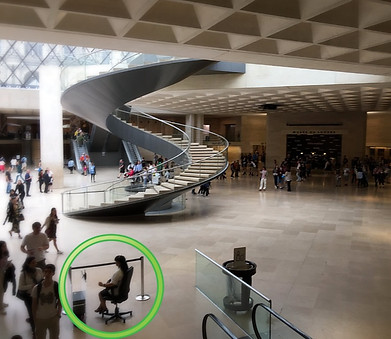

The museum advises visitors not to bring suitcases and luggage. Only baggage that does not exceed 55 x 35 x 20 cm (21.5 x 13.5 x 7.5 cm) can be accepted. inches) and should be placed in the (free) lockers, which work with a password, where you keep your belongings yourself, after the security check.
THE Musée du Louvre offers a series of services that facilitate our visit.
A team at the information desks located below the Pyramid is available to welcome you, help you and advise you on any question or doubt.

In these information places you will find:
- Location map (available in several languages, including Portuguese). For visitors with mobility impairments, a version of this map (in French and English) shows wheelchair access as well as elevators.
Strollers and wheelchairs are available free of charge for visitors who have difficulty getting around the museum.
- All the information you need to visit the museum and understand the layout of the collections, which is also available for download at: www.louvre.fr/en/plan


The museum offers guided tours (which must be booked in advance) lasting for 1h30min in multiple language options.
Free admission every first Sunday of the month, from October to March.

Watch the video: Paris, Le musée du Louvre (Full HD) - (04:33 min) - ToutParisEnVideo
Prepare your Visit!
Even if you have plenty of time, planning is essential!
Write down some tips!
Select your visit by priorities, preparing your itinerary in advance.
Print out the museum plan and make your own notes


✔ Due to the breadth of its collections and artwork transfers, the museum cannot keep all rooms open every day. There are also closed rooms for renovation and care. A weekly schedule containing the closing list of rooms, available in French, English and Japanese, It is also available online at: www.louvre.fr/en/hours-admission/schedule-room-closures

Detail of the folder available at the museum
very practical is the folder you buy at museum information desk. With it in hand, you can visualize all the closed areas. there they are the most sought-after works found in these spaces are indicated.
✔The calendar with all cultural events in the museum within a period of three months, which is also available online: www.louvre.fr/en/agenda
✔ Themed trails for children and/or adults are available upon request at the information desks. Some are available for printing in the Activities and Tours section: www.louvre.fr/en/parcours
✔There are four locations where you can rent an Audio Guide:
- one is located below the pyramid opposite the reception area.
- the other three are at the top of the escalators that lead to the three main entrances to the museum (Denon, Sully and Richelieu).
For more information: www.louvre.fr/en/audio-guide
✔ The museum offers free WiFi. Once connected, you get one hour of access, renewable and with no time limit.



✔ Everything in the museum is of extreme beauty and deserves your attention. Be sure to note:
- the views from the windows to the inner courtyards and outdoor area;
- the beautifully ornate ceilings;
- the floors that form beautiful designs
We have separated in our gallery a selection of these items that we highlighted above.
Our Gallery: Musée du Louvre



área externa do Louvre

✔ There is also an Audio Guide for iPhone and Android. If you prefer to use your own smartphone and keep a memory of your trip to the Louvre, you can download the "My Visit to the Louvre" app, either from home or at the museum.
I downloaded and loved it! It helped a lot! For more information: www.louvre.fr/en/new-app
✔ Photos without using Flash are allowed.

Works - Highlights
A visit to the Louvre Museum allows us to take a journey through history through the ages. Western art collections from the Middle Ages to 1848 and collections of ancient civilizations, which keep alive the memories of peoples and societies that are now extinct, are relics that visitors cannot miss.
The challenge is to discover (or rediscover) this monumental art encyclopedia in a short time.
We made a summary of the most sought after, most visited or of greatest interest in general. It is not a conclusive list; on the contrary, it is quite compact, and, for sure, along the labyrinthine paths, you will discover unforgettable works that are not included in this small selection. Even because the museum continues to grow with the policy of acquiring new works.

Where: Denon Wing, first floor, room 6
Work by Leonardo da Vinci (1452 - 1519), painted in Florence, Italy, between 1503 and 1506.
Mona Lisa (la Gioconda)
The enigmatic and serene smile, the look that accompanies us in any position we are in are just some of the traits that make this painting by Leonardo da Vinci one of the most emblematic works in the museum and one of the most famous paintings in the world.
There are several mysteries that surround this famous artistic creation. Historians, scientists and art lovers have studied (and still do) for centuries various aspects of this enigmatic image.
Napoleon Bonaparte fell in love with the figure from the first time he saw it, so much so that he ordered it to be placed in his quarters...
Many historians believe that the model used for the painting may have been the wife (Lisa del Giocondo) of Francesco del Giocondo , a wealthy Italian merchant, hence the name “Gioconda” or “Mona Lisa”. Some suggest, however, that the Mona Lisa would actually be a self-portrait of Leonardo, dressed as a woman.
In August 1911, the painting was stolen by a former museum employee. It was found two years later in Italy.
In fact, given the size of the room and other works exhibited there, it seems quite small with its 77x53cm...

Consider visiting the Louvre early in the morning, in the early hours of opening. Try to plan your visit, starting your tour with the most famous works, such as the Monalisa. The visit will be much more pleasant. I have already tried this option with great results. Monday is also a good choice, as many tourists who were unable to obtain advance information consider that the museum may be closed. Tuesday is the day that the Louvre remains closed for visitors.

room where Monalisa is on display, on a day with a large audience for visitation
Venus de Milo
Described as a representation of Venus (or Aphrodite), goddess of beauty and love, was found near the ancient city of the island of Milo (also known as Milos or Melos), in Aegean Sea in 1820 and acquired in 1821, a gift from King Louis XVIII.


Where: Sully Wing, ground floor
Greek sculpture worked in marble measuring 204 cm, dating from approximately 130 BC.
victory of Samothrace
The marble figure of the winged Greek goddess Nike, the messenger goddess of Victory, discovered in 1863 in the ruins of the Sanctuary of the Great Gods on the Greek island of Samothrace, north of the Aegean Sea in Greece, dates to the Early 2nd century BC. It is considered one of the great treasures of the Hellenistic period.


Greek sculpture, despite having a heavy marble structure, enchants with the smooth, yet energetic form of its movements and the naturalism of the flowing lines of its drapes.
The base of the Victory of Samothrace depicts the bow on one ship of war, which leads us to believe that it was consecrated in thanks to the gods after a victorious naval battle.
Height:
Sculpture with wings: 328cm
Boat: 200cm
Base: 36cm

Where: Denon Wing, Greek Sculpture department, first floor, reigning supreme at the top of the Daru stairs.
Some works from the Department of Greek Sculptures




The Wedding of Canaan
This oil on canvas, painted between 1562 and 1563 by Paolo Véronèse (1528 - 1588), is the largest painting on display in the Louvre. It represents the New Testament episode where Jesus Christ turns water into wine at a wedding.

Detail of the largest oil on canvas exhibited at the Loure, which represents what would be the first miracle attributed to Jesus Christ
Where: Denon Wing, first floor, room 6
Dimensions: 666x990cm


Napoleon's Coronation

detail of oil on canvas representing the Consecration of Napoleon, in Notre-Dame Cathedral
Where: Denon Wing, first floor, room 75.
Work by Jacques-Louis David (1748 - 1825); the picture was painted between the years 1805 and 1807.
Dimensions: 621x979cm
Some curiosities:
✔ Napoleon, who would be crowned by the Pope (ceremony held at Notre-Dame Cathedral, in 1804), removed the crown from his hands and crowned himself Emperor, as shown in the picture, then crowning Josephine, his wife.
✔ Napoleon's mother, who was not present at the ceremony, occupies a prominent place in the painting.


detail of oil on canvas - Napoleon's Coronation
Liberty Leading the People

Where: Denon Wing, first floor, room 77
Dimensions: 260x325cm
Work by Eugène Delacroix (1798 – 1863), oil on canvas, 1830, which symbolizes the spirit of the French Revolution.
The artist portrayed Liberty as a woman of the people, holding the tricolor flag on one side and a bayonet on the other, leading the revolutionaries, who pass over the defeated.
In the distance, you can see the towers of Notre-Dame . It is speculated that the boy next to the woman was the inspiration for the character. Gavroche , from “Les Miserables”, from Victor Hugo .

The Virgin and Child with Santa Anna
The painting represents the Virgin Mary embracing the baby Jesus (who plays with a lamb), sitting at the feet of his mother, Sant'Anna. The lamb, near a cliff, is a symbol of Jesus' sacrifice, remembered in John the Baptist's mention of Jesus as the "Lamb of God".
Where: Denon Wing, Room 5
Dimensions: 168x130 cm
Another splendid work by Leonardo da Vinci (1452 - 1519), oil on wood, painted in the period from 1508 to 1510
The Lacemaker
Johannes Vermeer's oil on canvas, probably finished in 1670, is a small but remarkable painting that shows us the details of a seamstress completely focused on her craft. The light wall is probably part of the Dutch painter's technique to draw attention exclusively to the girl's work, minimizing the distraction of observers.

Detail of the folder available at the museum
Where: Richelieu Wing, second floor, room 38
Dimensions: 24x21 cm
Gabrielle d'Estrées and One of Her Sisters

Where: Richelieu Wing, second floor, room 10
Measures 96x125 cm
Anonymous work, from 1594, which expresses the influence of the School of Fontainebleau, Italian Renaissance art. The gesture may be a reference to the pregnancy of Gabrielle d'Estrées (who is holding a ring) and the birth, in 1594, of César de Vendôme, the illegitimate son of Henry IV, of whom she was his mistress. The scene of a woman sewing, in the background, seems to corroborate this idea, perhaps trying to portray the making of the baby's layette.
Medusa's Raft
Important French composition from the 19th century, considered an icon of Romanticism. It describes the sinking of a frigate of the French Royal Navy off the coast of Senegal in 1816. The bodies reflect the despair of some sailors and the hope of rescue of others, in a raft built precariously with boards and parts of the ship's mast.
Where: Denon Wing, first floor, room 77.
Work by Théodore Géricault (1791 – 1824), from 1819.

Michelangelo's Slaves
The two slaves express completely different emotions. The one known as “Slave Dying” (229 cm) is young and handsome, and apparently is in a deep, resigned sleep. The other, called the “Rebel Slave” (215 cm), seems to contort his torso and move in a painful way in order to free himself.
Probably dating from 1515, these two works are part of a set made to adorn the tomb of Pope Julius II (1505) and Michelangelo began sculpting them in 1513. Four other slaves are in Florence, Italy.
Several tool marks left on the sculptures prove that the work is unfinished.
Where: Denon Wing, ground floor, room 4
Michelangelo Buonarroti (1475 – 1564)

Hammurabi's Code
Set of Babylonian Laws, developed during the reign of Hammurabi (1792-1750 BC) of the 1st dynasty of Babylon. It is the emblem of Mesopotamian civilization and an extraordinary source of information about the society, religion, economy and history of that period.
The scene represents an encounter between King Hammurabi and the Sun God, Shamash, which, in theory, legitimized his sovereignty and conferred power status on the code.
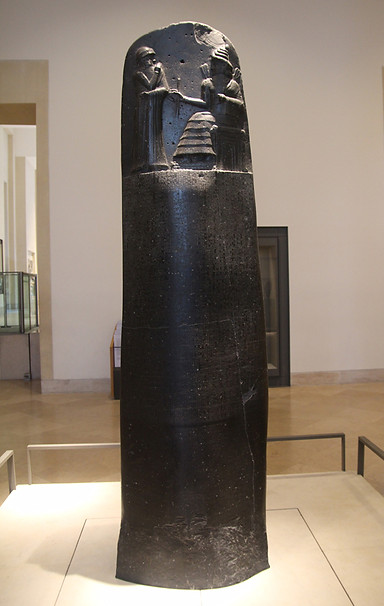
Where: Richelieu Wing, ground floor, room 3
The Human Headed Winged Bulls

They were protectors – monumental sculptures combining man, bull and bird – placed as guardians at certain gates or entrances to the city and palace, built for the glory of the Assyrian king Sargon II (721 – 705 BC).
The face is that of a bearded man with a prominent nose and it is particularly interesting to note that the anatomy of the body is that of a bull that has not four but five legs, so that it appears to be standing still when viewed from the front and walking when viewed from the side. side. From the shoulders sprout the wings of a bird of prey.
Where: Richelieu Wing, ground floor
Dimensions: 420x436 cm
Statue of Ramses II
The sculpture depicting Pharaoh Ramses II seated on a throne with hieroglyphic inscriptions at the base and belt buckle is one of the most important works on display in the Ancient Egypt sector.
Ramses II, known as Rameses the Great, was the third Pharaoh gives 19th Egyptian Dynasty . Reigned between approximately 1279 BC and 1213 BC It was perhaps the longest reign in Egyptian history.

Where: Sully Wing, ground floor
Dimensions: 259x80x120 cm
Psyche Reanimated by the Kiss of Eros

Work carved in 1793 by Antonio Casanova
(1757 - 1822)

Where: Denon Wing, ground floor.
Dimensions: 155x168 cm.
Having been plunged into a deep sleep by Aphrodite, jealous of her beauty, the mortal Psyche is brought back to life by the kiss of Eros, god of Love, also known as Cupid.
The moment when Cupid has just arrived - so much so that his wings are still raised and form an X with the body of his beloved - is made magical by the hands of neoclassical master Antonio Casanova. The purity of the lines and graceful intertwined forms give the marble work a remarkable lightness.



the three graces
the three graces are one of the most famous compositions of ancient Greece, having been reproduced and recreated by many artists over the centuries.
Graces, Latin name of Charis (comes from Charis, Greek word meaning charisma) Greek, were the goddesses who personified fertility, enchantment, beauty, sweetness, youth, friendship and joy.
Their names were Euphrosyne, Thalia and Aglaia. Three young muses who are usually depicted together, holding each other's shoulders.
Sculpture by Jean-Jacques Pradier (1790-1852)
Where: Denon Wing, first floor
Measure: 172 cm
Venus and the Three Graces Offering Gifts
to a young woman
Venus, the goddess of love, accompanied by the delicate “Three Graces”, offers a gift to the young woman dressed in red.

Work by Sandro Botticelli, dated 1485.
Where: Denon Wing, first floor, room 1.
Dimensions: 211 x 283 cm
A Young Man Being Introduced to the Seven Liberal Arts
Venus, in addition to beauty, also represented knowledge, a theme often portrayed in various periods of Art History. The disciplines that were part of the seven liberal arts and summarized the wisdom of the time were: rhetoric, dialectic, arithmetic, grammar, geometry, astronomy and music.

Work by Sandro Botticelli, dated from 1485.
Where: Denon Wing, first floor, room 1.
Dimensions: 237 x 269 cm
Alessandro di Mariano di Vanni Filipepi (1445 - 1510) , better known as Sandro Botticcelli, painter and draftsman of the Renaissance school, had the gift of portraying the lightness of features and the conception of the ideal of feminine beauty. In her works we can see the contrast between the women of real life and the goddesses of mythology. These have freedom... they are fluid in gestures, hairstyles and clothes. Those are demure in dress and prudish even in their movements.
In the Louvre, in the Denon Wing, there are two frescoes by Botticelli transferred to canvas. There are few paintings by the author that do not depict religious themes and that have survived, despite the damage suffered over time.


The Virgin and Child by Jeanne d'Evreux

Where: Richelieu Wing, first floor, Department of Decorative Arts.
Height: 68 cm

The Gothic-style sculpture, made of gilded silver, pearls, precious stones and enamels, typical of the first half of the 19th century. XIV, depicts the Virgin Mary holding her son, Jesus, in her lap. The boy caresses his mother's face, who gazes at him with a loving gaze.
At that time, it was common to represent the Virgin with a baby, symbolizing love, protection, affection and tenderness.
Four miniature lions support the weight of the base. and statuettes of prophets divide the small niches where scenes from the childhood and Passion of Christ are portrayed.
The delicate work, which belonged to Jeanne d'Evreux, was created between 1324 and 1339 and donated to the Basilica of Saint-Denis in 1339.
Mary's Horses


Where: Richelieu Wing, ground floor

Considered a masterpiece of French sculpture, the “Horses of Marly” were commissioned by Luίs XIV to Guillaume Coustou for the decoration of his former royal residence in Marly, near Versailles. In 1794, they were transferred to Paris and installed in the Place de la Concorde, at the entrance to Av. des Champs Élysées. Later, in 1984, they were replaced by copies and the originals, in Carrara marble, transferred to the Louvre.
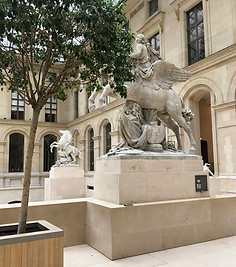


Napoleon's Apartment
Napoleon III's apartment is an extraordinary record of the decorative arts of the Second Empire.
Sumptuousness, luxury and ostentation are particularities of the project.
The wealth of details fascinates visitors.
The roof features Charles-Raphaël Maréchal's painting of “The Reunification of the Louvre and the Tuileries” by Napoleon III.
Where: Richelieu Wing, first floor


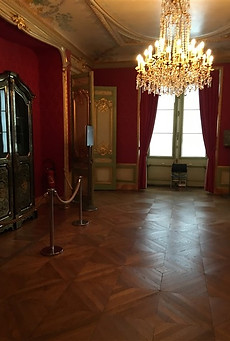
Choosing a special visit - check the options!
Guided tours provide opportunities to discover and discuss the museum's artwork.
The “Masterpieces” tour, for example, entitled “Welcome to the Louvre” takes you to the main works and sites of the Louvre, such as the medieval moat, as well as telling the history of the Palace.
- other tours (available in French) are based on unique themes relating to the history of art, an artistic genre, an artist, a collection or temporary exhibitions.
You can find a detailed list of tours here: www.louvre.fr/en/visites-guidees
Museum tours are led by guides from the network of national museums (Reunion des Musées Nationaux). Even if you're an experienced visitor, it's worth checking out the themes on offer (some only in French).
Specific activities are also available for visitors with disabilities, linked to museum events or temporary exhibitions: descriptive and “touch” tours, French Sign Language (LSF) tours or French Lip Reading (LL) tours.
The Tactile Gallery is a place in the museum where visitors are encouraged to touch the works. The gallery has plaster or resin casts of the original sculptures displayed in the Louvre, in various sizes and materials. The exhibitions provide opportunities for the visually impaired, as well as children and visitors who want to experience the tactile sensation of the museum's artworks.
For more information on visits and special workshops: www.louvre.fr/en/accessibility
In addition to the works...
RESTAURANTS AND CAFETERIA
Some restaurants and cafes inside the Louvre provide us with a “tasty” moment, in addition to a well-deserved rest.
 |  |
|---|---|
 |  |
 |  |
You will find options for a coffee break, snack, or lunch. Among the various options: Angelina (Louvre) and Paul
CARROUSEL DU LOUVRE
Boutiques offer you books, products based on the exhibitions and various other souvenirs and art objects that will make your visit even more interesting.



Click on the word Google on the map to view the area and plot your route
Drag the doll on the map to the red balloon to visit the place


Write down !
Musee du Louvre - 75058 Paris
Metro: line 1 (Palais-Royal–Musée du Louvre)
Schedule:
Wednesday to Monday, from 9 am to 6 pm. Evening hours on Wednesdays and Fridays until 9:45 pm. There are no night hours on holidays.
Free entry on the first Sunday of the month from October to March only.
Closed
January 1
May 1
December 25
Check the other closing days during the year at www.louvre.fr/horaires-et-tarifs
Click on a tourist spot to know more...






